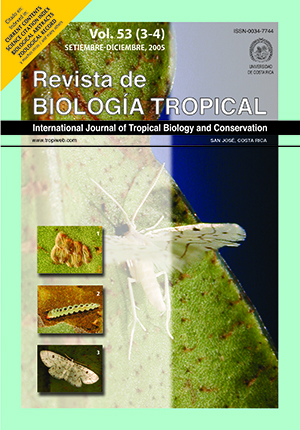Abstract
The loss and transformation of habitat by anthropogenic activities is one of the main causes of biodiversity decrease. Amphibians are declining all over the world and one of the causes of this decline is thought to be habitat reduction. However, there are anuran populations in highly disturbed habitats, like cities. This study presents the ecological baseline needed to understand anuran communities in urban environments, for Salta City, Argentina (ca. 502 000 inhabitants). The sample was stratified by environments defined by infrastructure and geographic location. The species were identified by visual encounter techniques and by auditory transect during the 2002-2003 reproductive period. Three families, seven genera and twelve species were recorded and the species richness decreased from city border to center. Similarity index values among geographic areas was higher East-West (94.7) than South-West (33.3). Bufo arenarum was the only species recorded in all environments. Hyla andina and Odontophrynus americanus had a restricted distribution and are here considered vulnerable. The border effect can explain some distribution pattern in these populations. A map of the potential distribution of recorded species for Salta is providedReferences
Alford, R. & S. Richards. 1999. Global Amphibian Declines: A Problem in Applied Ecology. Annu. Rev. Ecol. Syst. 30: 133-165.
Blaustein, A.R., Wake D.B. & W. Sousa. 1994. Amphibian Declines: Judging Stability, Persistence & Susceptibility of Populations to Local & Global Extinctions. Conserv. Biol. 8: 60-71.
Boone, M.D. & R.D. Semlitsch. 2001. Interactions of an insecticide with larval density & predation in experimental amphibian communities. Conserv. Biol. 15: 228-238.
Boone, M.D., R.D. Semlitsch, J.F. Fairchild & B.B. Rothermel. 2004. Effects of an insecticide on amphibians
in large scale experimental ponds. Ecol. Applic. 14: 685-691.
Bradford, D.F., A.C. Neale, M.S. Nash, D.W. Sada & J.R. Jaeger. 2003. Habitat match occupancy by toads
(Bufo punctatus) in a Naturally fragmented desert landscape. Ecology 84: 1012-1023.
Bridges, C.M. & R.D. Semlitsch. 2001. Genetic variation in insecticide tolerance in a population of southern leopard frogs (Rana sphenocephala): Implications fos amphibian conservation. Copeia 1: 7-13.
Burger, J., C. Jeitner, H. Jensen, M. Fitzgerald, S. Carlucci, S. Shukla, S. Burke, R. Ramos & M. Gochfeld. 2004. Habitat use in basking northern water (Nerodia sipedon) & eastern garter (Thamnophis sirtalis) snakes in urban New Jersey. Urb. Ecosyst. 7(1): 17-27.
Caseres, M.A. 1989. Río Arenales. Su origen, su importancia y su contaminación. Revista Crecer. Salta, s.p.
Hanken, J. 1999. Why are there so many new amphibian species when amphibians are declininig?. TREE 14 (1): 7-8.
Heyer, W.R., M.A. Donnelly, R.W. McDiarmid, L.A. Hayek & M.S. Foster (eds.). 1994. Measuring & m Monitoring Biological Diversity. Standard Methods for Amphibians. Smithsonian Institution, Washington, D.C. 364 p.
Hicks, N.G. & S.M. Pearson. 2003. Salamnder diversity & abundance in forests with alternative land use histories in the Southern Blue Ridge Mountains. For. Ecol. Manag. 177: 177-130.
Hostetler, M. & C.S. Holling. 2000. Detecting the scales at which respond to structure in urban landscapes. Urb. Ecosyst. 4 (1): 25-54.
Houlahan, J. E., C.S. Findlay, B.R. Schmidt, A.H. Meyer & S.L. Kuzmin. 2000. Quantitative evidence for
global amphibian population declines. Nature 404: 752-755.
Islam, S., M.T.H. Chowdhury & M. Rahman. 2004. Urban & peri-urban aquaculture as an immediate source of food fish: Perspectives of Dhaka City, Bangladesh. Urb. Ecosyst. 7: 341-359.
INDEC. 2002. Encuesta Permanente de Hogares. Salta, Argentina.
Kiesecker, J.M., A.R. Blaustein & L.K. Belden. 2001. Complex causes of amphibian population declines. Nature 410: 681-684.
Knutson, M., J.R. Sauer, D.A. Olsen, M.J. Mossman, L.M. Hemesath & M.J. Lannoo. 1999. Effects of landscape composition & wetland fragmentation on frog & toad abundance & species richness in Iowa & Wisconsin, USA. Conserv. Biol. 13 (6): 1437-1446.
Knutson, M., J.R. Sauer, D.A. Olsen, M.J. Mossman, L.M. Hemesath & M.J. Lannoo. 2000. Landscape associations of Frog & Toad species in Iowa & Wisconsin, USA. J. Iowa Acad. Sci. 107(3): 134-145.
Knutson, M.G., W.B. Richardson, D.M. Reineke, B.R. Gray, J.R. Parmelee & S.E. Weick. 2004. Agricultural ponds support amphibian populations. Ecol. Applicat. 14: 669-684.
Krebs, C.J. 1989. Ecological Methodology. Harper & Row, Nueva York, Nueva York, EEUU.
Longcore, T. & C. Rich. 2004. Ecological ligth pollution. Ecol. Envirom. 2: 191-198.
Mazerolle, M.J. 2004. Amphibian road mortality in response to nightly variations in traffic intensity. Herpetologica 60 (1): 45-53.
Mcintyre, N.E., Knowles-Yánez K. & D. Hope. 2000. Urban ecology as an interdisciplinary field: differences
in the use “urban” between the social and natural sciences. Urb. Ecosyst. 4 (1): 5-24.
Pope, S.E., L. Fahrig & H.G. Merriam. 2000. Landscape complementation and metapopulation effects on leopard frogs population. Ecology 81: 2498-2508.
Rubbo, M.J. & J.M Kiesecker. 2005. Amphibian breeding distribution in an urbanized landscape. Conserv. Biol. 19: 504-511.
Skelly, D.K., K.L. Yurewicz, E.E. Werner & R.A. Relyea. 2003. Estimating decline and distributional change in amphibians. Conserv. Biol. 17: 744-751.
##plugins.facebook.comentarios##

This work is licensed under a Creative Commons Attribution 4.0 International License.
Copyright (c) 2005 Revista de Biología Tropical






